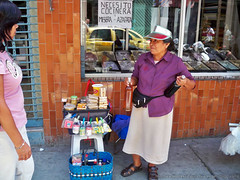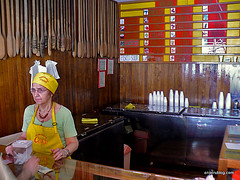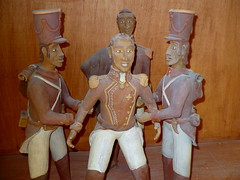La tapada limeña
The muslim Moors who conquered much of Spain left their mark there – for hundreds of years after the Christian reconquering many Islamic traditions continued to be followed in the south. The Moors impact on Spanish culture is visible in the language, the architecture and typical dress.
In South America these Islamic influences were brought from Spain by Spanish immigrants in the times of the various vice royalties – during Spain’s colonial height.
In the Vice royalty of Peru which consisted of almost all non-Portuguese South America, Lima was the seat of power and home of the Spanish. This was a time of great wealth. Colonial Lima was a city, known at the time as the City of Kings, with the most beautiful and exquisite colonial buildings. Each building was dominated by its grand wooden balconies, perfectly carved, some pieces even shipped from Spain. The Moorish style of the patterns on some of these buildings is not the Islamic influence I want to draw your attention too, it’s how the balconies were used and who by.
 In the times of the vice royalties and even up until some decades after independence it remained custom for Limean women to wear a form of dress very similar to that of Muslim women – the Muslim women of old Spain. The dress consisted of a puffy European exaggerating-hips style skirt that covered all the the legs and draped onto the floor, but not such as it would stop their perfectly embroided shoes being seen. On top women would wear a shroud, that was incorporated into the top part of the outfit, that was wrapped around the front of the body hiding its shape and continued up until and was wrapped around the face and head. This allowed the woman visibility from only one eye and shielding her from the eyes of others. It wasn’t all modesty and preventing unwanted attention from men who would not even know if the woman were even he sister at first glance, sometimes the dress was used flirtatiously – so it seems the Islamic custom had been diluted quite a bit.
In the times of the vice royalties and even up until some decades after independence it remained custom for Limean women to wear a form of dress very similar to that of Muslim women – the Muslim women of old Spain. The dress consisted of a puffy European exaggerating-hips style skirt that covered all the the legs and draped onto the floor, but not such as it would stop their perfectly embroided shoes being seen. On top women would wear a shroud, that was incorporated into the top part of the outfit, that was wrapped around the front of the body hiding its shape and continued up until and was wrapped around the face and head. This allowed the woman visibility from only one eye and shielding her from the eyes of others. It wasn’t all modesty and preventing unwanted attention from men who would not even know if the woman were even he sister at first glance, sometimes the dress was used flirtatiously – so it seems the Islamic custom had been diluted quite a bit.
It wasn’t considered appropriate in this time for women to go out on the street. If going outside was necessary the women would wear the dress described. To allow the women to observe the goings on in the street while not actually having to leave the home, buildings were constructed with grand balconies from which they could look out below.
The women of this time were known as the limeñas tapadas, the covered limean women, and although the vice royals tried to discourage the use of the dress the old Muslim habits died hard.
Lima’s balconies –
Tags: 1500s, 1600s, 1700s, 1800s, architecture, balconies, colonial, islam, lima, moors










